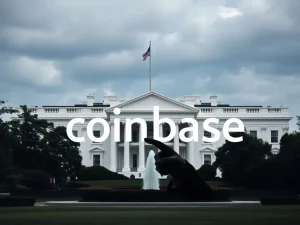Explosive Stablecoin Growth: 3 Reasons Global Adoption Booms – Will US Regulation Follow Under Trump?

The world of digital currencies is constantly evolving, and one segment experiencing truly explosive growth is stablecoins. While Bitcoin and other cryptocurrencies capture headlines with price swings, stablecoins are quietly becoming the workhorses of the crypto economy, particularly in emerging markets. Their promise of stability amidst volatility is proving incredibly attractive, even in regions with limited banking infrastructure and uncertain regulatory landscapes. This raises a critical question: Will the United States, especially with potential shifts in administration under Trump, adapt to this global trend and foster a more crypto-friendly environment to capitalize on stablecoin growth?
Why is Stablecoin Growth Booming Globally?
The surging popularity of stablecoins isn’t a mystery. Several key factors are driving their global adoption, particularly in regions where traditional financial systems fall short. Let’s delve into the top three reasons fueling this remarkable expansion:
1. Bridging the Gap in Unbanked and Underbanked Regions
In many parts of the world, access to traditional banking services is limited or nonexistent. Millions remain unbanked or underbanked, facing challenges in accessing basic financial tools. Stablecoins offer a powerful alternative. Here’s why they are a game-changer:
- Accessibility: All that’s needed is a smartphone and internet access, bypassing the need for physical bank branches or complex documentation.
- Lower Fees: Traditional banking in emerging markets can be expensive, with high transaction fees and limited competition. Stablecoins offer significantly lower transaction costs, making them ideal for everyday transactions and remittances.
- Faster Transactions: Cross-border payments through traditional channels can be slow and cumbersome. Stablecoins facilitate near-instantaneous transactions, crucial for businesses and individuals operating internationally.
Consider countries in Latin America, Africa, and Southeast Asia. These regions often grapple with volatile local currencies and limited access to USD or other stable currencies. Stablecoins pegged to the US dollar provide a safe haven and a reliable medium of exchange, empowering individuals and businesses alike. This real-world utility is a major driver of stablecoin growth.
2. Navigating Regulatory Uncertainty in the Crypto Market
The cryptocurrency market is known for its volatility and, in many jurisdictions, regulatory ambiguity. This uncertainty can be a major barrier to entry for both individuals and institutions. Stablecoins offer a degree of stability and predictability in this otherwise turbulent space:
- Reduced Volatility: Unlike volatile cryptocurrencies like Bitcoin or Ethereum, stablecoins are designed to maintain a stable value, typically pegged to a fiat currency like the US dollar. This reduces the risk associated with price fluctuations, making them more appealing for everyday use and long-term holding.
- Predictable Value for Transactions: Businesses and individuals can confidently use stablecoins for payments and settlements, knowing their value will remain relatively stable. This predictability is essential for commerce and financial planning.
- Gateway to Crypto Ecosystem: For newcomers to the crypto world, stablecoins often serve as a less intimidating entry point. Their stable value makes them easier to understand and use compared to more volatile cryptocurrencies.
In regions where US regulation of cryptocurrencies is still evolving, stablecoins provide a familiar anchor in the digital asset space. They bridge the gap between traditional finance and the decentralized world, fostering greater confidence and participation in the crypto market.
3. Fueling Innovation in the Digital Currency Landscape
Stablecoins are not just about stability; they are also catalysts for innovation in the broader digital currency landscape. Their programmability and efficiency are unlocking new possibilities across various sectors:
- Decentralized Finance (DeFi): Stablecoins are the backbone of many DeFi protocols, facilitating lending, borrowing, and yield farming activities. Their stability is crucial for the smooth functioning of these decentralized financial ecosystems.
- Cross-Border Remittances: As mentioned earlier, stablecoins are revolutionizing cross-border remittances, offering faster, cheaper, and more transparent alternatives to traditional money transfer services.
- Programmable Money: Stablecoins can be programmed to automate payments, streamline supply chains, and create new forms of financial instruments. This programmability opens up a vast range of potential applications.
The innovation spurred by stablecoins is driving further global adoption and attracting attention from both traditional financial institutions and tech companies. As the digital currency space matures, stablecoins are poised to play an increasingly central role.
Will US Regulation Catch Up Under Trump?
The question now turns to the United States. While stablecoin growth is undeniable globally, the US regulatory landscape remains somewhat uncertain. The approach taken by the US government will significantly impact the future trajectory of stablecoins and the country’s position in the global crypto economy.
Here are a few potential scenarios to consider, especially with the possibility of a Trump administration:
| Scenario | Potential US Regulatory Approach | Impact on Stablecoin Growth |
|---|---|---|
| Pro-Innovation & Deregulation | Reduced regulatory burden, focus on fostering innovation, potentially lighter touch regulation for stablecoins. | Significant boost to stablecoin adoption and innovation within the US. Could attract global crypto talent and investment. |
| Status Quo | Continued cautious approach, existing regulatory frameworks applied to stablecoins, focus on consumer protection and financial stability. | Moderate growth, but potentially slower compared to other regions with clearer and more favorable regulations. Some innovation may move offshore. |
| Increased Scrutiny & Regulation | Tighter regulations, stricter enforcement, potential for more restrictive rules on stablecoin issuers and usage. | Slower growth, potential chilling effect on innovation and adoption within the US. Could lead to the US falling behind in the global crypto race. |
It’s crucial to remember that predicting future US regulation is complex. Political shifts, technological advancements, and evolving global dynamics all play a role. However, recognizing the undeniable global adoption of stablecoins and their potential benefits is a critical first step for policymakers.
The Path Forward for Stablecoins
Stablecoins are not just a passing fad; they represent a fundamental shift in how people transact and interact with the financial system. Their explosive growth in emerging markets highlights their real-world utility and their potential to democratize finance.
For the US to remain competitive in the burgeoning digital currency landscape, a balanced and forward-looking regulatory approach is essential. This approach should:
- Embrace Innovation: Recognize the potential benefits of stablecoins and foster an environment that encourages responsible innovation.
- Provide Clarity: Establish clear and consistent regulatory guidelines to provide certainty for businesses and consumers.
- Prioritize Consumer Protection: Implement safeguards to protect users while enabling the growth of the stablecoin ecosystem.
Conclusion: Riding the Wave of Stablecoin Revolution
The stablecoin growth story is a compelling narrative of financial innovation and global adoption. As emerging markets lead the way in embracing these digital currencies, the US faces a critical juncture. Will it seize the opportunity to become a leader in the stablecoin revolution, or will it lag behind? The answer may well depend on the regulatory path chosen, particularly under potential future administrations. One thing is clear: stablecoins are transforming the financial landscape, and their impact will only continue to grow in the years to come. Staying informed and adapting to this evolving landscape is paramount for anyone involved in the world of finance and technology.








